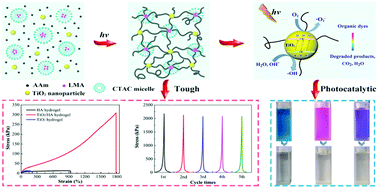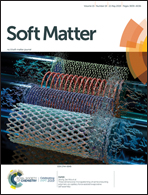Robust and anti-fatigue hydrophobic association hydrogels assisted by titanium dioxide for photocatalytic activity
Abstract
Currently, robust and functional hydrogels have attracted extensive attention due to their potential applications in wastewater treatment, farmland water conservation and other fields. Herein, a series of hydrophobic association hydrogels assisted by titanium dioxide (TiO2) was fabricated via one-pot in situ photo-induced polymerization. TiO2 nanoparticles could act as both photo-initiators and physical crosslinking points. The TiO2-assisted hydrophobic association hydrogels exhibited a high tensile strength of 306 kPa, superior compression strength of 2.17 MPa and excellent fatigue resistance. Simultaneously, the incorporation of TiO2 endowed the hydrogel with photocatalytic capacity for dye wastewater treatment based on the inherent nature of TiO2. The results indicated that the hydrogels contributed to the degradation of various ionic dyes including methylene blue, rhodamine B and bromophenol blue, and the removal of methylene blue achieved a rate of 96.63%. Significantly, the hydrogel could be repeatedly utilized and the removal rate showed no evident decrease after five cycles, indicating that the hydrogels could be powerful candidates as photocatalysts for dye wastewater treatment.



 Please wait while we load your content...
Please wait while we load your content...